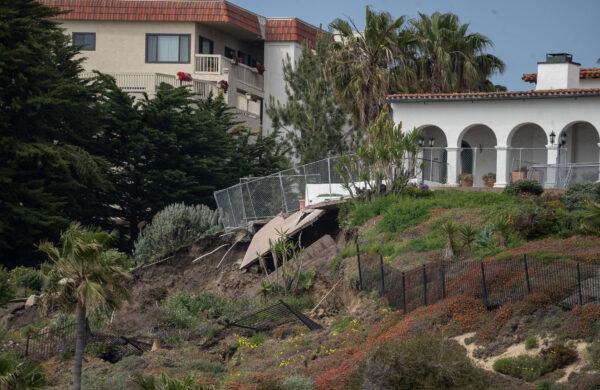University of California–Los Angeles (UCLA) geologists recently announced they are using artificial intelligence (AI) to predict where and why landslides may occur, bolstering efforts to save lives and property in disaster-prone areas.
Researchers say the new method, which was detailed in the journal Communications Earth and Environment, requires “far less” computing power than traditional AI and is more accurate than traditional landslide prediction methods.
The approach would be valuable to places like California, researchers say, where drought, wildfires, and earthquakes increase potential landslide disaster zones and where such conditions are expected to worsen amid stronger and wetter storms this past year.

Landslides strike a coastal neighborhood after heavy rains in San Clemente, Calif., on March 16, 2023. (John Fredricks/The Epoch Times)
According to school researchers, factors influencing where a landslide will occur include the shape of the terrain, its slope steepness and drainage areas, rainfall, and ground motion resulting from earthquakes. Geologists have traditionally estimated an area’s landslide risk by incorporating these factors into statistical and physical models, whereby scientists build physical recreations of the area being studied.
“With so many variables, predicting when and where a chunk of earth is likely to lose its grip is as much an art as a science,” UCLA spokesperson Holly Ober said in a statement announcing the project.
Researchers say traditional methods of predicting landslides like physical models are limiting because they are time- and resource-consuming and can’t be applied to larger areas being studied. Traditional statistical calculations also give little predictive insight, such as which risk factors increase the probability of landslides.

Damage is shown after a landslide next to Casa Romantica in San Clemente, Calif., on April 28, 2023. (John Fredricks/The Epoch Times)
Using Artificial Intelligence to Predict Landslides
In recent years, school researchers have trained AI bots to predict landslides by feeding them landslide-related information and variables, such as slope and rainfall, which in turn have created algorithms that can very quickly process and “learn” from the data to make “highly accurate” predictions.
Scientists, however, said they had to work through substantive hurdles when first using the AI bots.
Previously, they didn’t “show their work” in calculating landslide predictions, which made it difficult for researchers to interpret their output.
School researchers resolved the issue by creating newer networks within the bots, which separated the bot’s landslide calculations according to risk factors like rainfall.
Scientists used such data during the research process from the eastern Himalayan mountains. The region was selected because the majority of human losses due to landslides occur in Asia, according to the school, with a substantial portion occurring in that region.

A student walks toward Royce Hall on the campus of the University of California–Los Angeles in Los Angeles on March 11, 2020. (Robyn Beck/AFP via Getty Images)
“Similar to how autopsies are required to determine the cause of death, identifying the exact trigger for a landslide will always require field measurements and historical records of soil, hydrologic and climate conditions, such as rainfall amount and intensity, which can be hard to obtain in remote places like the Himalayas,” project co-researcher Seulgi Moon said in a school statement. “Nonetheless, our new AI prediction model can identify key variables and quantify their contributions to landslide susceptibility.”
The team said they plan to extend their work to other landslide-prone regions of the world.
In California, for example, where landslide risk is exacerbated by frequent wildfires and earthquakes, the school says the new system has the potential to help develop early warning systems in the region and predict other surface hazards, including floods.











